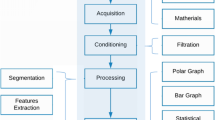Abstract
Introduction
In this paper, the nine directions are classified using the maximum likelihood estimation (MLE) based on electromyogram (EMG) obtained from both forearm. The authors compared the EMG features to confirm classification accuracy of nine directions.
Methods
Fifteen subjects participated in the experiment, were asked to act three types of motions for each forearm. The motions of left wrist were forward, backward, and rest, while the motions of right wrist were left, right, and rest. Three motions of left wrist and three motion of right wrist were combined to classify the nine directions. The EMG features with 166ms time-window for five seconds of each motion were extracted from the obtained EMG signals. The difference absolute mean value (DAMV), difference absolute standard deviation value (DASDV), mean absolute value (MAV), and root mean square (RMS) were chosen as the EMG feature to compare classification accuracy of nine directions.
Results
In the results, the average classification accuracy of 97.71% was confirmed for each of the nine directions. The DAMV had the highest classification accuracy in the EMG features with 99.26% accuracy. And DASDV had classification accuracy with 99.19%.
Conclusions
These results demonstrate that in this study the classification performance using DAMV or DASDV is stronger than that using MAV or RMS. Furthermore, the classified direction using DAMV or DASDV can be used as precise input data for controlling of robots and devices in rehabilitation applications.
Similar content being viewed by others
References
Kim JS, Kim HK, Jeong H, Kim KH, Lim SH, Son WH. Human-computer interface based on bio-signal. Elect Telecommun Trends. 2005; 20(4):67–81.
Lee YH, Choi CH, Kim SS, Kim DH. Detection of hand motions using cross-correlation of surface EMG. J Biomed Eng Res. 2004; 29(3):205–211.
Lee J, Kwon HM. Comparison of algorithms estimating linear regression line from surface EMG signals. JKIEE. 2008; 57(3):527–535.
Chu JU, Moon IH. A wavelet-based EMG pattern recognition with nonlinear feature projection. J Inst Elect Eng Kor. 2005; 42(2):39–48.
Alkan A, Gunay M. Identification of EMG signals using discriminant analysis and SVM classifier. Expert Syst Appl. 2012; 39:44–47.
Song YR, Kim SJ, Jeong EC, Lee SM. A gaussian mixture model pattern classification algorithm of forearm electromyogram. J Rehab Welfare Eng Assistive Tech. 2011; 5(1):95–101.
Wheeler KR. Device control using gestures sensed from EMG. IEEE Int Workshop Soft Comput Ind Appl. 2003; 21–26.
Kim MH, Park SB. The effect of bilateral activities of the upper Limb on motor performance of the affected Limb in children with hemiplegia. Kor J Sport Psychol. 2000; 11(2):57–76.
Phinyomark A, Phukpattaranont P, Limsakul C. Feature reduction and selection for EMG signal classification. Expert Syst Appl. 2012; 39:7420–7431.
Jenkins DB. Functional anatomy of the limbs and back. Hyunmoom Press; 2002.
Kim KS, Choi HH, Moon CS, Mun CW. Comparison of knearest neighbor, quadratic discriminant and linear discriminant analysis in classification of electromyogram signals based on the wrist-motion directions. Curr Appl Phys. 2011; 11(3):740–745.
Cho YJ, Kim JY. The limitation of interpretation of MPF parameter in muscle fatigue assessment. Fall Conf Ergon Soc Kor. 2008; 67–72.
Ahsan MR, Ibrahimy MI, Khalifa OO. EMG signal classification for human computer interaction: A review. Eur J Sci Res. 2009; 33(3):480–501.
Myung IJ. Tutorial on maximum likelihood estimation. J Math Psychol. 2003; 47:90–100.
Han HY. The introduction of pattern recognition. Han-bit media; 2005.
You KJ, Shin HC. Classifying finger flexing motions with surface EMG using entropy and the maximum likelihood method. J Inst Elect Eng Kor. 2009; 46(6):38–43.
Lee DH, Yoon KA, Bae DH. A missing data imputation by combining K nearest neighbor with maximum likelihood estimation for numerical software project data. Kor Inst Inform Sci Eng. 2009; 36(4):273–282.
You KJ, Shin HC. Hand motion inference using surface EMG signals. Summer Conf Inst Elect Eng Kor. 2009; 1131–1132.
Kim SM, Kang HG. Introduction to statistics using EXCEL. Donam Press; 2000.
Kim JS, Lee SS, Kim SJ, Yoon MS, Kwok SH. Introduction to statistics using EXCEL. Chung-ram Press; 2006.
Author information
Authors and Affiliations
Corresponding author
Rights and permissions
About this article
Cite this article
Yu, S., Jeong, E., Hong, K. et al. Classification of nine directions using the maximum likelihood estimation based on electromyogram of both forearms. Biomed. Eng. Lett. 2, 129–137 (2012). https://doi.org/10.1007/s13534-012-0063-x
Received:
Revised:
Accepted:
Published:
Issue Date:
DOI: https://doi.org/10.1007/s13534-012-0063-x




